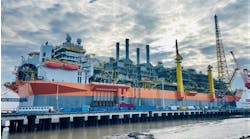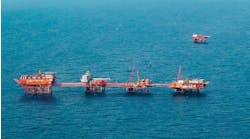Bruce Beaubouef • Houston
US GoM jackup market on the mend
After taking a beating during the recent downturn, the jackup market in the US Gulf of Mexico is now doing “pretty well,” according to recent analysis by Westwood Global Energy Group.
The Westwood report acknowledges that it is “difficult” to view a region with just 27 jackups and only 12 of those contracted “as warranting any special attention.” However, a deeper dive into the numbers shows that the US GoM jackup market “has quietly become one of the best in the world.” The firm notes that utilization of the 12-rig marketed fleet is 100% and contract backlog is increasing. Finally, day rates have risen, with anecdotal evidence suggesting that further increases for some segments of the fleet are not far off.
Of course, it should be remembered that this market is nowhere near what it once was, the report notes. Looking back to June 2000, supply reached 157 in March 2001, while the high point for the number of working rigs hit 144 a month later. However, by the end of 2001, the number of contracted units was under 100 and demand was well on its way to the historic low levels it ultimately reached. Supply was initially slower to react, but continued mobilization out of the region as well as retirements ultimately brought that number down as well. The end-result has been an 83% supply decrease and a 92% fall in demand between June 2000 and August 2018, declines not likely equaled by any other region over the same period.
However, also notable is the sharp upward spike in the utilization line in 2018. Since January, fleet supply decreased by 10 while demand rose by four, resulting in utilization more than doubling from 21% to 44% in August.
Looking at the current contracted fleet, seven of the 12 units are rated to work in up to 350-ft or greater. Six of the 12 units have work that will last until March/April 2019, with one already contracted to September of next year. In addition, another two rigs are expected to soon secure extensions that will extend their availability to mid-2019 or beyond. In a market where well-to-well contracts have generally been the norm, having nearly 70% of the fleet with 7-8 months of backlog is a welcome development for rig owners.
For operators, however, it is a different story as they are unable to find a jackup for their work that requires a long-legged unit, so much so that there is now talk of additional supply being speculatively mobilized to the region, a scenario not seen in this region in many years. Rowan’s Ralph Coffman was mobilized into the Gulf from Trinidad in February, but that was for a specific requirement that no available jackups already in the region could perform.
Helping drive this demand surge has been several recent noteworthy term contracts, many of which have not begun yet. Cantium LLC just signed a contract to take the Rowan EXL III for six months plus a three-month option, in addition to a one-year deal the operator inked with Enterprise Offshore Drilling jackup Enterprise 205 in April. ExxonMobil recently signed a seven-month contract with ENSCO that is likely to be extended, and Castex Offshore, which had previously signed a deal to pick up the ENSCO 68 for over 200 days, just exercised an option for a third well that will keep it busy for another 100 plus days. Talos Energy picked up an ENSCO jackup in May for an initial 120-day program. The company has already extended it for 90 days and at the time of writing extended it for a further nine months through September 2019.
Crowley Maritime Corp. says that it has delivered Shell’s Appomattox semisubmersible floating production system to the open waters of the US Gulf from Kiewit Offshore Services’ construction facility in Ingleside, Texas. Crowley’s Ocean Sky and Ocean Sun tugboats, on behalf of customer Heerema, worked together alongside other third-party assets to deliver Appomattox. (Courtesy Crowley Maritime Corp.)
Lease Sale 251 yields more than $178 million in high bids
The US Department of Interior reports that Lease Sale 251 generated $178,069,406 in high bids for 144 tracts covering 801,288 acres in federal waters of the Gulf of Mexico.
Twenty-nine companies submitted 171 bids that totaled $202,667,923.
Lease Sale 251 included 14,622 unleased blocks, located from 3 to 231 mi (5 to 372 km) offshore, in the Gulf’s Western, Central and Eastern Planning Areas in water depths ranging from 9 to more than 11,115 ft (3 to 3,400 m).
Highlights of the sale included:
• Exxon Mobil Corp. submitted 25 high bids totaling $40,555,000. Its highest bid, $8,503,880, was for the ultra-deepwater De Soto Canyon block 939.
• Hess Corp. submitted 16 high bids totaling $36,178,321. Its and the sale’s highest bid, $25,919,784, was for the ultra-deepwater Mississippi Canyon block 338.
• Chevron U.S.A. Inc. submitted five bids totaling $18,705,332. Its highest bid, $11,116,013, was for the ultra-deepwater Mississippi Canyon block 743.
• Equinor Gulf of Mexico LLC submitted 16 high bids totaling $13,224,672.
• BP Exploration & Production Inc. submitted 19 high bids totaling $12,571,230.
• Anadarko US Offshore LLC submitted five high bids totaling $12,481,890. Its highest bid, $3,887,975, was for the deepwater Green Canyon block 473.
• Shell Offshore Inc. submitted three high bids totaling $6,305,964. Its highest bid, $4,601,988, was for the deepwater Mississippi Canyon block 978. •





